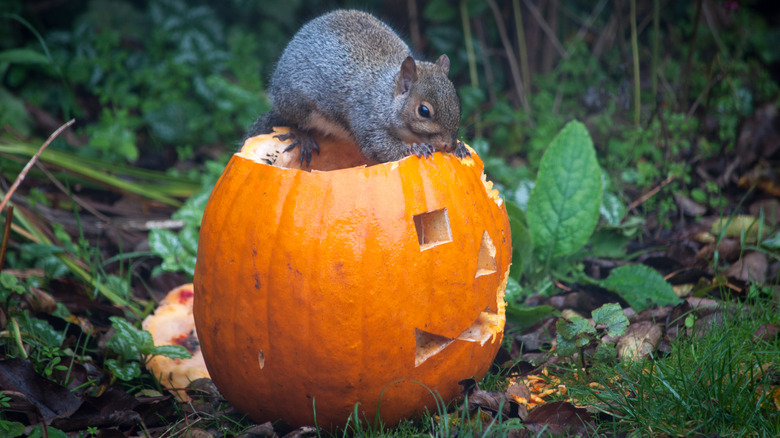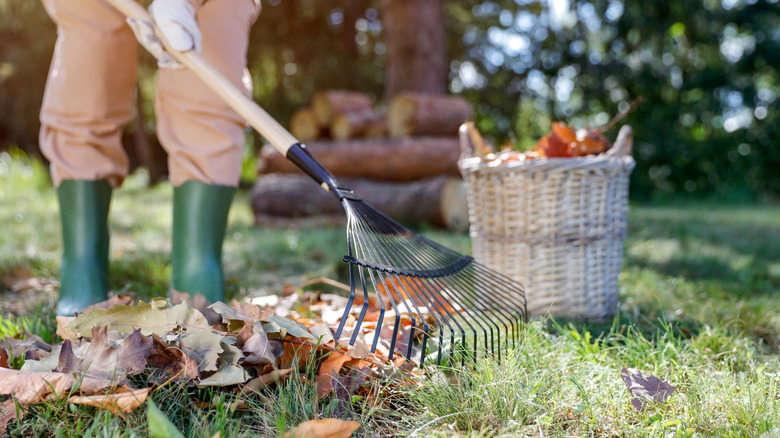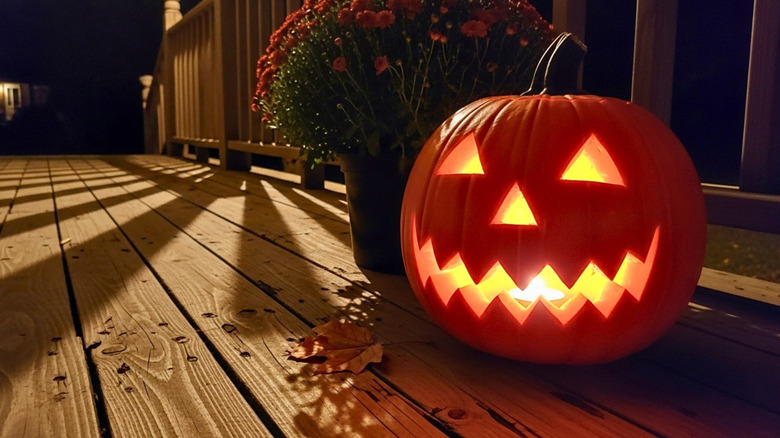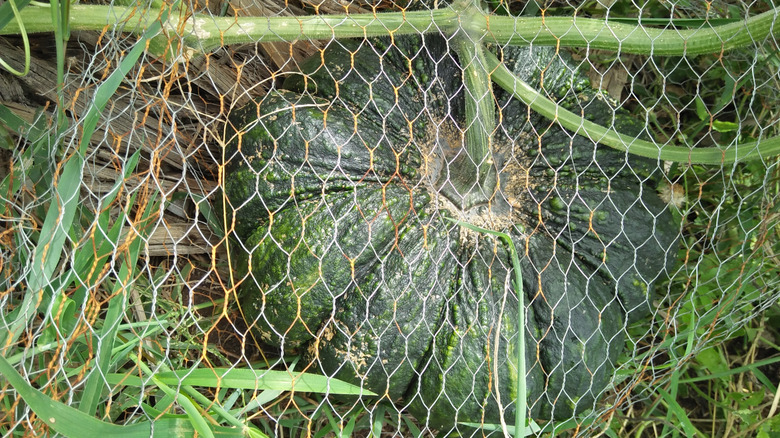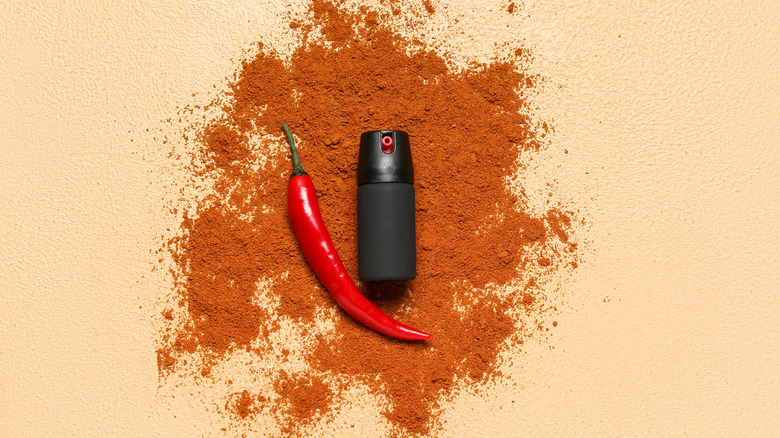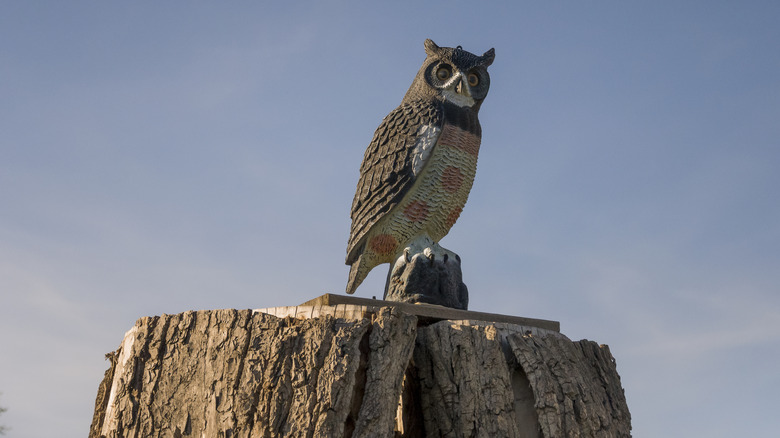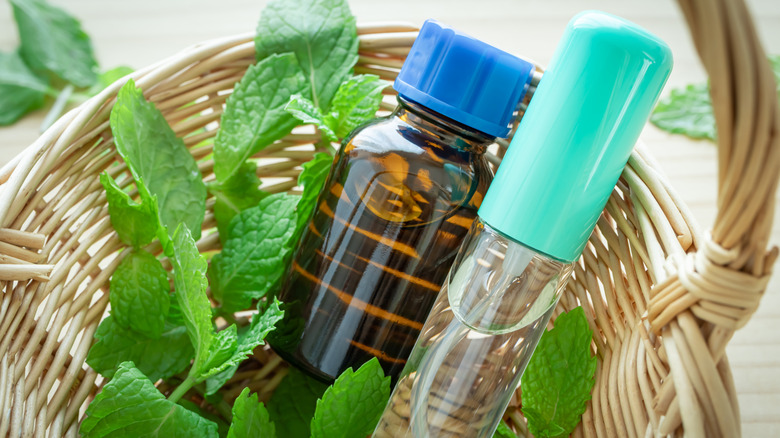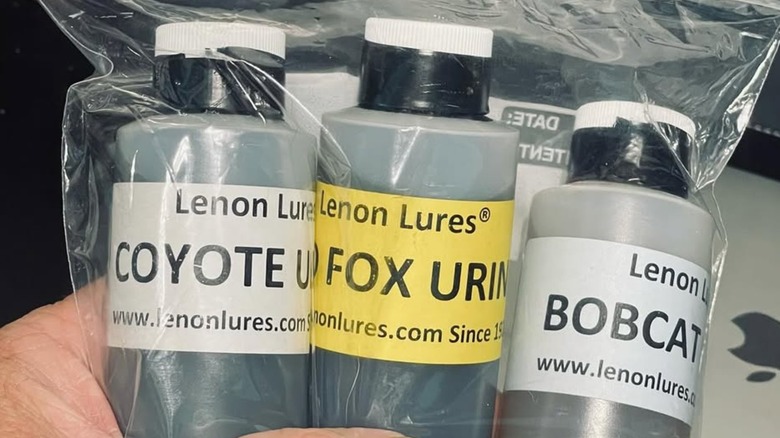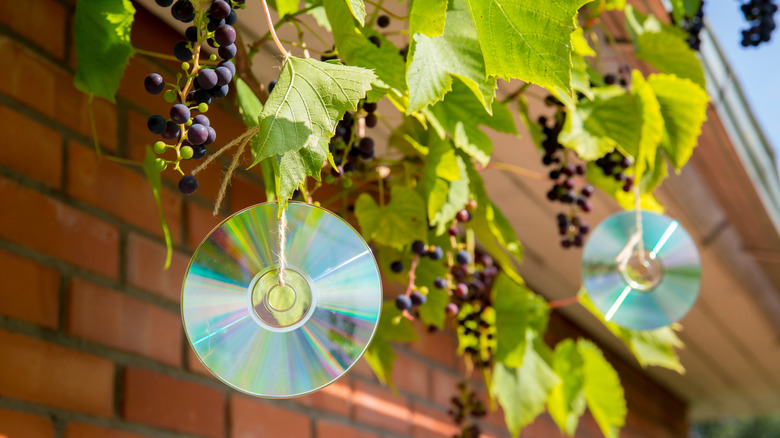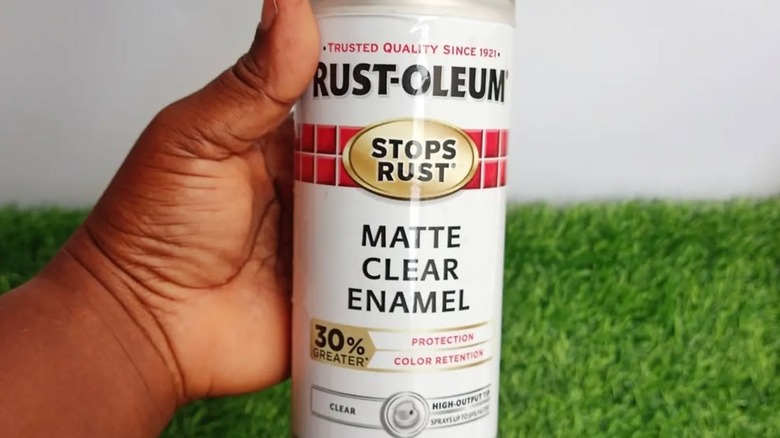13 Ways To Prevent Squirrels From Eating The Pumpkins In Your Garden
Few things signal the arrival of fall quite like a pumpkin patch in the garden or a few carved pumpkins displayed on the porch. As much as we love pumpkins for cooking or decorating, squirrels seem to love them even more. During this season, squirrels spend most of their days finding food and storing it for the winter. These little creatures are instinctually programmed to search out the easiest sources of nutrition possible, so sweet-smelling pumpkins out in the open become an easy target. Plus, pumpkins are rich in vitamins and nutrients that squirrels need, making them even more appealing.
If you don't want to wake up to a pumpkin covered in claw marks or half-eaten fruit, it's important to find ways to deter squirrels and other pests. Luckily, you, your pumpkins, and the squirrels can all coexist with a few eco-friendly deterrent tricks. The best ways to keep trespassing squirrels out of your yard or garden are to scare them, block them out, or make any potential rodent foods unappealing through scent or taste. Some squirrels can be quite determined, so you may want to use a few of the preventative measures below at once.
Keep your yard clean to stop attracting squirrels
While pumpkins can make an enticing treat for squirrels, they may not be the only thing that's luring squirrels into your yard. Squirrels are foragers, so they're always on the lookout for their next meal. Things like fallen acorns, fruit, and birdseed can all lure them in before they ever set sights on your pumpkins. In addition to food, yard clutter can give them plenty of areas to take cover and hide from predators. A tidy yard isn't just helpful for keeping squirrels out, but it also makes it an unappealing place for snakes and other pests.
If you want squirrels to stop snacking on your pumpkins, start by tidying up so you don't attract them in the first place. Rake up acorns, nuts, fruits, and routinely clean up fallen birdseed around your feeders to limit their food. It's also important to keep pet food, trash cans, and compost bins locked and stored away so squirrels can't access them. Put away any unused nesting boxes until the following season to prevent squirrels from turning them into winter homes. Prune overgrown trees or shrubs, especially those that give them access to your roof or eaves, and remove any brush piles they may use for cover.
Bring your pumpkin indoors when the sun goes down to keep squirrels from snacking
Like humans, squirrels are diurnal, so they spend their days foraging for food, building nests, or playing with other squirrels. Then, once the sun sets, they head to their nests to get some sleep. They're most active at dawn and dusk, so leaving your pumpkins outside overnight can make them vulnerable to squirrel scavenging. Squirrels are jumpy and will run away if they sense any threat, so they're less likely to venture into your yard in the middle of the day when people and pets are around. Once the sun goes down and it's quiet outside, they'll take the opportunity to grab a bite of your pumpkins.
If you're using pumpkins or squash as your fall decor, taking them in before bed is an easy way to protect them from the squirrels. Once it starts getting dark out, grab up any edible pumpkins and put them in the house, garage, or storage shed where squirrels can't gain access. Then, you can put them back outside once the sun is lighting up your yard again. Because squirrels still may pay a visit to your porch while you're away, it's a good idea to combine this method with another deterrent.
Use wire mesh netting to protect your pumpkins from squirrels
If you've been growing a pumpkin patch only for squirrels to come by and eat them all before you have a chance to harvest, it may be a good idea to physically block them out. A genius gardening hack that lets pollinators in but keeps squirrels out is to use wire mesh to cover them. When they try to access the fruit, the mesh covering creates a barrier that keeps their paws and teeth from getting through. That said, this may not be the best route to take if pumpkins are a part of your outdoor autumn display. While this is one of the most foolproof methods, wire mesh isn't exactly going to complement your seasonal decor.
Grab some wire mesh, such as DUSHILUKI's Hardware Cloth, which comes with gloves, wire cutters, and zip ties, so you have everything you need for your project. All you'll need to do is cut it to size with a pair of wire cutters and use the zip ties to hold the pieces together. Use the mesh to create small cages for individual pumpkins. Simply building a fence around them won't be sufficient, as the squirrels will easily be able to climb over it.
Spray your pumpkins with a chili pepper solution to repel squirrels
Hot peppers and pumpkins may be two ingredients that don't often go together, but if you're trying to keep squirrels out, it could be worth giving it a try. Squirrels strongly dislike the flavor and scent of capsaicin, an extract found in chili peppers. Similar to how spicy foods create a burning sensation for some people, capsaicin sprays trigger a similar reaction in squirrels. So, if they get a whiff of hot peppers instead of pumpkin, they're more likely to scurry off in the other direction.
You can easily make your own DIY squirrel repellent with a few basic ingredients. Mix 1 ounce of hot sauce and 3 drops of dish soap or vegetable oil with 4 cups of water in a spray bottle and shake to combine. Spray it all over your pumpkins, the surrounding area, and any other spots you'd like to keep them out. Be careful when using this, so you don't accidentally get this hot mixture in your eyes. Hold it away from your face, making sure a gust of wind won't blow it in the other direction. It's also a good idea to wash your hands thoroughly afterward to remove any potential residue. Remember to reapply periodically — especially after it rains.
Place a fake predator next to your pumpkins to scare squirrels
It's hard not to notice how fast-moving squirrels are, often bouncing around from spot to spot in what looks like random directions. In actuality, their agility is one of their most valuable survival instincts. Rather than attacking predators head-on, they'll use speed and unpredictable movements to get to safety. Because squirrels naturally flee at the first sign of danger, fake decoys like owls, snakes, or foxes can give them a visual cue that the area isn't safe.
Choose a realistic predator statue or two to set up near your pumpkins to make squirrels too afraid to feast. Some fake decoys, like Pestvanish's Fake Owl Decoy, have heads that move to make it even more realistic and terrifying for garden pests that venture onto your property. It's important to note that while this can work well for a while, these clever rodents may catch on that it's not a real animal. Because of this, it's best to rotate your decoys every so often, so squirrels don't get used to the placement.
Try a diluted peppermint essential oil spray to keep squirrels out
Peppermint is a scent that's loved by many, which is why it's often used in candles, lotions, and other home and beauty products. While the minty aroma is refreshing to us, rodents like squirrels can't stand overpowering smells (especially because their sense of smell is so strong), which is what makes peppermint essential oil a great way to keep them away from your pumpkins. When a squirrel approaches your garden or porch, it'll be met with the strong menthol scent of peppermint, rather than the sweet pumpkin smell that would ordinarily attract it.
There are a few ways you can use peppermint essential oils to keep your decorations or pumpkin patch free of rodents. One option is to soak cotton balls in the oil and place them around the area or even inside a carved pumpkin. Because it's concentrated, the fragrance will be potent and thus unappealing to squirrels. Alternatively, you can make an easy homemade repellent by mixing 15 drops of peppermint essential oil into 1 cup of water. Add it to a spray bottle and spritz the area around your pumpkins. The scent won't stick forever, so make sure to respray or refresh your cotton balls regularly to keep squirrels at bay.
Set up a squirrel feeder away from your pumpkins to distract squirrels
If your yard has become a hangout for hungry squirrels, you may have better luck directing them to another spot than trying to keep them out. Squirrels are always on the lookout for the easiest way to fulfill their needs. So, if the most convenient food source for them is your pumpkins, they'll head straight for those, rather than searching elsewhere. By making a dedicated squirrel feeder, they'll still get easy access to their favorite treats, and you won't have to deal with half-eaten pumpkins sitting in your yard.
You can either purchase a feeder or make a DIY squirrel feeder using items like a mason jar and scrap wood. No matter what you go with, the most important aspect of feeding squirrels is placement. Make sure to hang it as far away as possible from your pumpkins, flower bulbs, bird feeders, or any other areas of your yard that you'd prefer to keep squirrel-free. They aren't too picky, but the healthiest foods for them are unsalted seeds or nuts like white oak acorns, sunflower seeds, walnuts, hazelnuts, or pecans. It can also help to use another deterrent near your pumpkins to teach them that the area isn't worth returning to.
Lather your pumpkins in a slippery substance to keep squirrels off
You may have noticed that squirrels use their tiny paws to get a good grip on their food when they eat. So, it makes sense that lathering your pumpkins in a slippery substance will make it challenging for them to grab hold, keeping them from chowing down. While this can be an effective hack, it's important to avoid any ingredients that may be harmful to squirrels. Some people recommend using petroleum jelly or similar substances — however, it can be harmful if ingested, and squirrels tend to lick their paws clean after touching the slippery surface.
Rather than using a potentially harmful product to ward off squirrels, opt for something that's more animal-friendly. For example, Squirrel-Slip is made from natural ingredients, so it'll offer the same slick deterrent, but without putting these little creatures at risk. Alternatively, coconut oil can be a squirrel-safe alternative you may already have sitting in your pantry. All you need to do is grab a bit out of the tub and cover the entirety of your pumpkins in it. You'll likely need to apply another coat after a rainfall or once it starts wearing off.
Use predator urine to scare squirrels away from your pumpkins
Squirrels have an impressive sense of smell, which is partially why it's so easy for them to locate the pumpkins you have out on display. Furthermore, it turns out that squirrels can even "smell danger," or more specifically, a predator's urine. Unlike urine from non-threatening animals, predator urine contains kairomones, or chemicals that signal to squirrels that a dangerous animal is lurking nearby. So if a squirrel wanders into your yard and smells coyote, fox, or another one of their predators' urine, they'll deem the area as unsafe. As a bonus, it can also ward off other pests. For example, PredatorPee's Pure Coyote Urine is said to deter rats, raccoons, weasels, groundhogs, deer, and other unwanted animals.
Luckily, you don't have to cover your beloved pumpkins in urine if you want to keep squirrels out. Instead, spray it on the ground surrounding your pumpkins, near the porch, or around any spots you'd like to protect. If you like, you can even line the perimeter of your property with the predator urine to attempt to keep them out entirely. The scent will naturally fade over time, so make sure to reapply it regularly to maintain its effectiveness. Keep an eye out for squirrel activity or rainfall as an indicator of when it's time to reinforce the boundary.
Install motion-sensor sprinklers to keep squirrels at bay
Squirrels get scared off pretty easily, and sometimes, all it takes is quick movement to send them packing. While you may use sprinklers to keep your lawn healthy and green, they can also work surprisingly well against squirrels. The quick blast of water startles them, making them think twice about continuing in the same direction. The best option is to use motion-activated sprinklers, which will turn on immediately once the sensors pick up on movement. Even if you're not home, the sprinkler will shoot a burst of water at the squirrel, causing it to run far away from your pumpkins.
Set up your motion-activated sprinkler near where your pumpkins are located and aim the sensor at a squirrel's height to ensure it'll go off as soon as one runs by. Once it's ready, there isn't much else you'll have to do aside from checking to make sure the sensors are working from time to time. The main downside to using sprinklers in the fall is that they can freeze in cold weather. So, make sure to turn off the system and rely on other deterrents when temperatures drop below freezing. Also, it's smart to rotate them from time to time to keep squirrels guessing.
Try spraying a commercial squirrel repellent on your pumpkins
There's no secret why squirrels eat the pumpkins in your yard — they're hungry and there's tasty food readily available for them. By making the flavor of your pumpkins something they can't stand, they'll have no reason to keep trying to eat them. Ingredients like Thiram, castor oil, garlic, and soap all work wonders to make pumpkins unappetizing to squirrels. Rather than purchasing all of the supplies and trying to mix a squirrel-repelling concoction yourself, you can instead use commercial squirrel repellent that contains these deterrents.
Squirrel repellents can typically be found at your local retail stores or online, but ideally, choose a humane solution that won't cause any harm when they ingest it. Products like IMUSTGARDEN's Squirrel Repellent contain all-natural ingredients that squirrels hate, like garlic, white pepper, castor oil, and lemongrass oil. When combined, it creates a pungent blend of odors and flavors that squirrels detest, so they'll likely search for food elsewhere. Cover your pumpkins inside and out (if carved) to transform them into a squirrel's least favorite food combination. Once it starts wearing off, simply give your pumpkins another coat to keep them smelling and tasting awful to hungry rodents.
Use holographic items or iridescent foil to help scare off squirrels
Surprisingly, one genius way to use aluminum foil in your outdoor living space is to startle squirrels. In fact, any iridescent, holographic, or other bright metal objects will do the trick. As the sun hits the surface of the object, it'll naturally reflect in several different directions. As the squirrel runs up to sniff out your pumpkins, it'll be hit with a sudden beam of light that may scare it away. While the bright flash can work to deter rodents, it's even more effective if you use a type of material that makes noise when the wind blows by. This way, it'll trigger two of the squirrel's senses, further encouraging it to scamper away.
There are several types of foil ribbons and other decoys you can find online or at garden centers, but you may have some reflective objects sitting away in storage. For example, if you have an old box of CDs you never listen to, you can hang them up in your yard. The reflective surface will flash lights and colors, startling any squirrels that come close to your pumpkins. Aluminum foil can also be effective, as it's both shiny and makes noise. You can cut strips and attach them to stakes or ball up a few pieces and leave them near your pumpkins. Because squirrels can adapt to deterrents over time, rotate the placement or swap materials occasionally to keep them guessing.
Seal whole pumpkins with some spray gloss enamel
If you don't want your carved or decorative pumpkins to be ravaged by squirrels, consider sealing them with a spray gloss enamel. Not only will it give your pumpkins a polished look, but it can also make them less appealing to these tiny rodents. It works by creating a thin, protective barrier that masks the pumpkin's scent and taste, which are what typically attract squirrels in the first place. Plus, many people swear by this DIY solution to make pumpkins last longer, as the enamel can help slow down the decay.
To keep your pumpkins squirrel-proof and delay their rotting, start by wiping down your pumpkin to remove any dirt or debris. Once it's dry, spray the entire pumpkin with an enamel sealant in your preferred finish, whether matte or glossy. Although it may feel like it's dry right away, make sure you give the enamel time to fully set. You should let it sit for at least an hour, but it's best to follow any directions listed on the label of your chosen product. Some people have success with this method, and their pumpkins remain free of squirrels all season. Others have said it works best if you use an additional deterrent if your yard has some desperate squirrels willing to chew through the seal.
